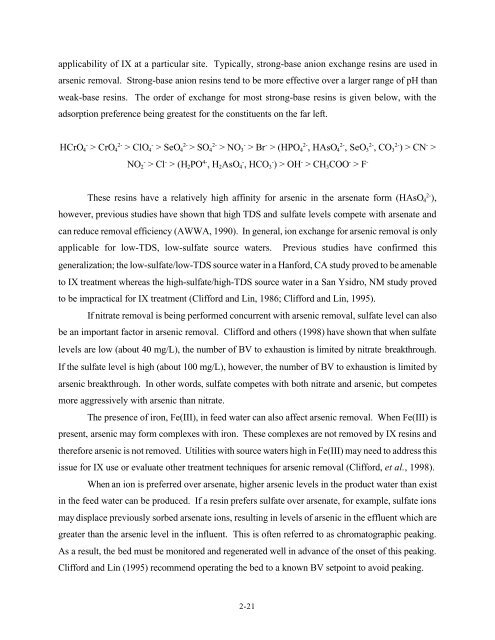Technologies and Costs for Removal of Arsenic From Drinking Water
Technologies and Costs for Removal of Arsenic From Drinking Water
Technologies and Costs for Removal of Arsenic From Drinking Water
You also want an ePaper? Increase the reach of your titles
YUMPU automatically turns print PDFs into web optimized ePapers that Google loves.
applicability <strong>of</strong> IX at a particular site. Typically, strong-base anion exchange resins are used inarsenic removal. Strong-base anion resins tend to be more effective over a larger range <strong>of</strong> pH thanweak-base resins. The order <strong>of</strong> exchange <strong>for</strong> most strong-base resins is given below, with theadsorption preference being greatest <strong>for</strong> the constituents on the far left.HCrO 4-> CrO 42-> ClO 4-> SeO 42-> SO 42-> NO 3-> Br - > (HPO 42-, HAsO 42-, SeO 32-, CO 32-) > CN - >NO 2-> Cl - > (H 2 PO 4- , H 2 AsO 4- , HCO 3- ) > OH - > CH 3 COO - > F -2-These resins have a relatively high affinity <strong>for</strong> arsenic in the arsenate <strong>for</strong>m (HAsO 4 ),however, previous studies have shown that high TDS <strong>and</strong> sulfate levels compete with arsenate <strong>and</strong>can reduce removal efficiency (AWWA, 1990). In general, ion exchange <strong>for</strong> arsenic removal is onlyapplicable <strong>for</strong> low-TDS, low-sulfate source waters. Previous studies have confirmed thisgeneralization; the low-sulfate/low-TDS source water in a Han<strong>for</strong>d, CA study proved to be amenableto IX treatment whereas the high-sulfate/high-TDS source water in a San Ysidro, NM study provedto be impractical <strong>for</strong> IX treatment (Clif<strong>for</strong>d <strong>and</strong> Lin, 1986; Clif<strong>for</strong>d <strong>and</strong> Lin, 1995).If nitrate removal is being per<strong>for</strong>med concurrent with arsenic removal, sulfate level can alsobe an important factor in arsenic removal. Clif<strong>for</strong>d <strong>and</strong> others (1998) have shown that when sulfatelevels are low (about 40 mg/L), the number <strong>of</strong> BV to exhaustion is limited by nitrate breakthrough.If the sulfate level is high (about 100 mg/L), however, the number <strong>of</strong> BV to exhaustion is limited byarsenic breakthrough. In other words, sulfate competes with both nitrate <strong>and</strong> arsenic, but competesmore aggressively with arsenic than nitrate.The presence <strong>of</strong> iron, Fe(III), in feed water can also affect arsenic removal. When Fe(III) ispresent, arsenic may <strong>for</strong>m complexes with iron. These complexes are not removed by IX resins <strong>and</strong>there<strong>for</strong>e arsenic is not removed. Utilities with source waters high in Fe(III) may need to address thisissue <strong>for</strong> IX use or evaluate other treatment techniques <strong>for</strong> arsenic removal (Clif<strong>for</strong>d, et al., 1998).When an ion is preferred over arsenate, higher arsenic levels in the product water than existin the feed water can be produced. If a resin prefers sulfate over arsenate, <strong>for</strong> example, sulfate ionsmay displace previously sorbed arsenate ions, resulting in levels <strong>of</strong> arsenic in the effluent which aregreater than the arsenic level in the influent. This is <strong>of</strong>ten referred to as chromatographic peaking.As a result, the bed must be monitored <strong>and</strong> regenerated well in advance <strong>of</strong> the onset <strong>of</strong> this peaking.Clif<strong>for</strong>d <strong>and</strong> Lin (1995) recommend operating the bed to a known BV setpoint to avoid peaking.2-21
















